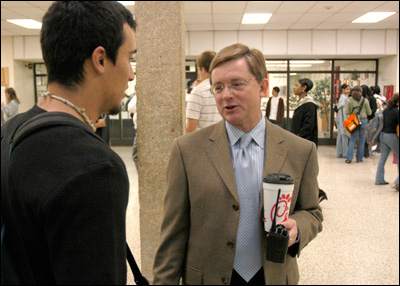 |

Year 1: Part 1 Western Guilford High School, where Angela Johnson taught English for so many years, is a sprawling brick building surrounded by parking lots and playing fields. It's a good school by most measures. The majority of students go on to college. S.A.T. scores are a bit above the national average. The school was built in 1968 for 300 students. Back then this was a rural area, almost all white, lots of farms. Now the school sits at the suburban edge of the city of Greensboro. There are apartment complexes on those former farms, and shopping plazas, gas stations and big box stores down the road.  Western Guilford High School Principal Randy Shaver talks with a student before class. Photo by Billy Barnes The principal of Western Guilford High School is Randy Shaver. It's the fall of 2005. Shaver's day starts with an appearance at the main office, to make sure there's nothing urgent to deal with. Then, with a can of Tab in one hand and a walkie-talkie in the other, he wanders into the sea of students milling around an open area outside the cafeteria. In the fall of 2005, there are nearly 1500 students at this school. And Shaver knows many of them by name. He says hello, asks what classes they're in, how things are going. Everyone's waiting for the morning bell, gathering in groups along the walls and trophy cases. White students are still the majority here - 60 percent. The rest are mostly African-American, with a small but rapidly growing population of Latinos and foreign-born students. Shaver's been in education for 30 years. He was a teacher for most of that time. This job at Western is his first as a high school principal. He's just starting his third year here. He says every student deserves a chance at a good education. "Even the worst kid, the ones that we have in here on a regular basis we call our frequent flyers because of discipline problems. They all have a story," he says. "And like I tell all my teachers and my administrators, 'If you don't love every one of them, and you don't want to find a better life for them, then go sell insurance.'" This is basically the message of No Child Left Behind: every student - black, white, rich, poor, students who don't speak English, students with learning disabilities - they all must learn, it's the school's job to make sure they do. And everyone in education will tell you that for a long time, schools didn't serve all kids, especially high schools. Shaver says they focused on the top students who were easy to teach, up to speed, and motivated. They just assumed everyone else would get a job or go into the military. "And a lot of them, we know, left without being able to read or write at a literate level, and that's not fair to them," says Shaver. Look at the test scores and you'll see what he's talking about. On the most recent state standardized tests, 82 percent of white students at Western passed, but only 54 percent of low-income students did, and 51 percent of African Americans. This is the achievement gap that education experts talk about, and there are gaps like this at most American high schools. The goal of No Child Left Behind is to eliminate these gaps. Shaver believes in the goal and says testing is essential. His attitude: you can't help failing students until you know who they are. His job is to find them, help them, and prove that he helped them by raising their test scores. And he is under intense pressure to do it fast. Last year, because of the achievement gap, Western did not make adequate yearly progress, the fedreal government's testing goal under No Child Left Behind. Miss AYP two years in a row and the government says you're a failing school. Shaver's job is to get Western to make AYP. Standing in his way: the students at the bottom. "Alls I pretty much do is kind of hang out with my friends. That's pretty much it. And listen to a lot of music," says Jessica Giardullo, a 15-year-old freshman at Western. She wears band t-shirts, torn sneakers, and black eyeliner. She writes in her journal a lot, and she dreams of being a writer. But school is something she's never taken very seriously, perhaps because school has never made her feel very good about herself. "Pretty much since about 1st grade, people have told me, 'Umm, you're average level with everybody else.' I didn't really care," she says. "I was like, 'That's cool, whatever.'" For Jessica, school has always been this thing that was kind of "against" her, slapping her with labels. In kindergarten: attention deficit disorder. In 5th grade: special ed class. And for a reason. By the end of elementary school, Jessica says she could still barely read. Her test scores were awful. Her grades were just as bad. But a lot has changed in the past few years. She's a confident reader now. In fact, she loves books, and dreams of going to a top school like NYU. "Do you have any idea how I'd love to live in a city like New York?" she asks. "I want to become a journalist, make something of myself. God, I wish I could go right now." But if Jessica's going to make it to NYU, she needs to turn things around pretty fast. Bring her grades and test scores up, take some high level classes. Most of all, she must see the connection between doing better in school and getting what she wants out of life. In many ways, Jessica is an opportunity for Western. The school needs the low performers to do better, and Jessica wants to do better. Can Western help Jessica to improve her performance and get what she wants?
Continue to Year 1, Part 2
|